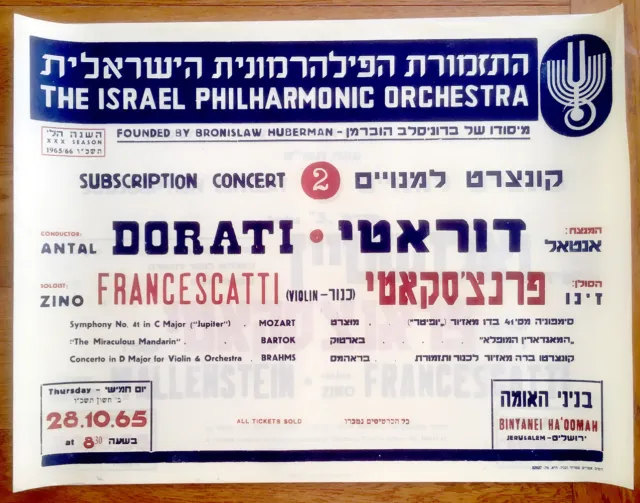1965 Violin RARE CONCERT POSTER Israel FRANCESCATTI Violinist DORATI Bartok IPO
$115.00 Buy It Now or Best Offer, $29.00 Shipping, 30-Day Returns, eBay Money Back Guarantee
Seller: judaica-bookstore ✉️ (2,816) 100%,
Location: TEL AVIV, IL,
Ships to: WORLDWIDE,
Item: 285834531096
1965 Violin RARE CONCERT POSTER Israel FRANCESCATTI Violinist DORATI Bartok IPO.
DESCRIPTION : Up for auction is an extremely rare CONCERT POSTER announcing and advertising the upcoming VIOLIN CONCERT performance of two MUSICAL GIANTS : The acclaimed JEWISH conductor ANTAL DORATI and the renowned French VIOLINIST - ZINO FRANCESCATTI .
The VIOLIN CONCERT took place almost 60 years ago in 1965 in JERUSALEM ISRAEL. FRANCESCATTI and the IPO under the baton of DORATI played pieces
by MOZART , BRAHMS and BARTOK . Size around 27 x 19
" . Hebrew & English. Very good condition . ( Pls look at
scan for accurate AS IS images ) Will be sent inside a protective
rigid sealed tube .
PAYMENTS : Payment method accepted : Paypal & All credit cards . SHIPPMENT
:SHIPP worldwide via registered airmail is $ 29 . Will be sent inside a protective
rigid sealed tube . Will be sent around 5-10 days after payment .
René-Charles "Zino" Francescatti (August 9, 1902 – September 17, 1991) was a French virtuoso violinist.
External audio
You may hear Zino Francescatti performing Johannes Brahms's Violin Concerto in D major, Op. 77 with Eugene Ormandy conducting the Philadelphia Orchestra in 1956 Here on archive.org
Zino Francescatti was born in Marseilles, to a musical family. Both parents were violinists. His father, who also played the cello, had studied with Camillo Sivori. Zino studied violin from age three and was quickly recognized as a child prodigy. He began performing at the age of five and made his debut at age 10, playing Beethoven's Violin Concerto.[citation needed]
In 1927 he went to Paris to teach at the École Normale de Musique; he also conducted the Concerts Poulets. He made his first world tour in 1931 and his American debut with Sir John Barbirolli and the New York Philharmonic in 1939, playing Paganini's Violin Concerto No. 1. His recording of the concerto is still regarded as one of the best. For three decades after 1945 he had an exceptionally impressive international career.
A violinist of outstanding technical ability, Francescatti played all of the great concerti. His performances of Mendelssohn's Violin Concerto in E minor, Saint-Saëns Violin Concerto No. 3, Bruch's Violin Concerto No. 1, and others, continue to be fondly remembered and highly regarded.
Francescatti made many renowned LPs, including a set of the complete Beethoven violin-piano sonatas with Robert Casadesus, a frequent musical collaborator of his. Both in concerts and on disc, he performed on the celebrated "Hart" Stradivarius of 1727. Upon his retirement in 1976, he sold the instrument and established the Zino Francescatti Foundation, to assist young violinists, in La Ciotat. In 1987 an international violin competition was organized in his honor in Aix-en-Provence.[citation needed]
He died in La Ciotat, Bouches-du-Rhône, France, aged 89.
Quotes[edit]
External audio
You may hear Zino Francescatti performing Sergei Prokofiev's Violin Concerto No. 2 in G minor , Op. 63 with Dimitri Mitropoulos conducting the New York Philharmonic in 1952 Here on archive.org
"Known for his lyrical performance style and as a champion of contemporary violin music by such composers as Darius Milhaud, Leonard Bernstein, and Karol Szymanowski." - Encyclopædia Britannica
"Francescatti's playing was marked by a seemingly effortless technique, warmth of expression, and tonal elegance. "[1]
"One of the great classical violinists of the twentieth century. Among his recordings are Saint-Saëns's famous and popular Introduction and Rondo Capriccioso, with Leonard Bernstein conducting the New York Philharmonic." [2]******
.EBAY5347
Francescatti, Zino (actually, René-Charles), eminent French violinist; b. Marseilles, Aug. 9, 1902; d. La Ciotat, Sept. 17, 1991.
He studied with his father René, a violinist and cellist, and with his mother Erneste, a violinist. When he was only 5, he made his public debut in a recital. At age 10, he appeared as soloist in the Beethoven Violin Concerto. After making his Paris debut in 1925, he toured England in duo recitals with Ravel in 1926. He soon established himself as a virtuoso via tours of Europe and South America. On Nov. 18, 1939, he made his U.S. debut as soloist in Paganini's 1st Violin Concerto with Barbirolli and the N.Y. Philharmonic After the close of World War II in 1945, he pursued an outstanding international career until his retirement in 1976. He then sold his celebrated "Hart" Stradivarius of 1727 and established the Zino Francescatti Foundation in La Ciotat to assist young violinists. In 1987 an international violin competition was organized in his honor in Aix-en-Provence. Francescatti's playing was marked by a seemingly effortless technique, warmth of expression, and tonal elegance. *****Zino Francescatti
Biography
Showing all 5 items
Jump to: Overview (2) | Mini Bio (1) | Trivia (2)
Overview (2)
Born August 9, 1902 in Marseille, Bouches-du-Rhône, France
Died September 17, 1991 in La Ciotat, Bouches-du-Rhône, France
Mini Bio (1)
Zino Francescatti was born on August 9, 1902 in Marseille, Bouches-du-Rhône, France. He is known for his work on Accord final (1938), Le violon de l'orphéon (1957) and The Bell Telephone Hour (1959). He died on September 17, 1991 in La Ciotat, Bouches-du-Rhône.
Trivia (2)
One of the great classical violinists of the twentieth century. Among his recordings are Saint-Saens's famous and popular "Introduction and Rondo Capriccioso", with Leonard Bernstein conducting the New York Philharmonic.
He was awarded a Star on the Hollywood Walk of Fame for Recording at 6704 Hollywood Boulevard in Hollywood, California. ****
Zino Francescatti Is Dead at 89; Violinist Renowned for Lyricism
By Edward Rothstein
Sept. 18, 1991
Credit...
The New York Times Archives
See the article in its original context from
September 18, 1991, Section A, Page 20Buy Reprints
New York Times subscribers* enjoy full access to TimesMachine—view over 150 years of New York Times journalism, as it originally appeared.
SUBSCRIBE
*Does not include Crossword-only or Cooking-only subscribers.
About the Archive
This is a digitized version of an article from The Times’s print archive, before the start of online publication in 1996. To preserve these articles as they originally appeared, The Times does not alter, edit or update them.
Occasionally the digitization process introduces transcription errors or other problems; we are continuing to work to improve these archived versions.
Zino Francescatti, the French violin virtuoso, died yesterday at his home in La Ciotat, France. He was 89 years old.
He had been in failing health, a family friend said.
Mr. Francescatti did not perform publicly in the last 15 years, but his recordings of the concerto repertory, along with his sonata recordings with the pianist Robert Casadesus, remain models of interpretive grace and technical polish. His phrasing was liquid and his tone refined, whether he was playing a Beethoven Violin Concerto or the Faure Sonata.
In his performing style, Mr. Francescatti combined the heritage of Italian vocal lyricism and fine-grained French tone. But he did not emerge out of a particular school of violin playing -- his only teachers were his parents -- nor did he teach or leave behind a heritage of younger players imitating his style. 'A Noble Art'
At the peak of Mr. Francescatti's career, in 1947, Virgil Thomson reviewed his playing in The New York Herald Tribune:
"Everywhere there was beauty, dignity, repose and the authority of solid worth. If violin playing is in the way of becoming a noble art again . . . this artist is one of those responsible for the change."
Mr. Francescatti's father, Rene, was a violinist and cellist in Marseilles, France, who studied with Paganini's only pupil, Ernesto Sivori (to whom six of Paganini's violin sonatas were dedicated). Mr. Francescatti's mother, Erneste, was also an accomplished violinist who had studied with her husband before her marriage.
Thanks for reading The Times.
Subscribe to The Times
The young Zino, whose given name was also Rene but who preferred his nickname, was prodigious in his early talent and affection for the violin, even taking the instrument to bed with him at age 3. He gave his first public recital at age 5 and played the Beethoven Concerto when he was 10. But his father did not wish him to have the life of a child prodigy and finally discouraged his musical career, arguing, from first-hand experience, that it would not be financially secure. From Law to Music
Mr. Francescatti began to study law but turned to a musical career at age 22, when his father suddenly died, leaving the family without income. He auditioned with Jacques Thibaud in Paris and made his debut in a concert at the Paris Opera. In 1928 he met Ravel and accompanied the composer on a tour of Britain, performing his chamber and violin works.
When he returned to Paris, he was dismayed at how difficult it was to earn money as a solo violinist and asked the conductor of the Orchestre Straram for a steady section job instead of a solo engagement. He then began teaching at the Ecole Normale, where the pianist Alfred Cortot and the cellist Pablo Casals were also on the faculty. He also became the assistant concertmaster of the Concerts Poulet orchestra.
Under the management of Leon Delort, his international career began to flourish with important tours of South America, Europe and finally, in 1939, the United States, where Arthur Judson of Columbia Concerts was his sponsor.
Editors’ Picks
This Is Your Brain on Junk Food
Sharon Stone Is Telling Her Side of the Story
Searching for Roger Federer
Continue reading the main story
During the following decades, Mr. Francescatti's playing earned high praise for his effortless virtuosity and stylish interpretations, as well as moderate criticism for his unvaried elegance.
After his retirement, Mr. Francescatti sold his renowned "Hart" Stradivarius to establish the Zino Francescatti Foundation in La Ciotat to help young violinists, a foundation led by his wife, Yolande, who was also trained as a violinist.
In 1958, Mr. Francescatti told Harold C. Schonberg of The New York Times: "My philosophie is never to fight a piece. I only want to give the impression that music is poetic, beautiful and easy." By all accounts, he generally succeeded.
He is survived by his wife. ***Zino Francescatti, original name René-Charles Francescatti, (born Aug. 9, 1902, Marseille, France—died Sept. 17, 1991, La Ciotat), French virtuoso violinist known for his lyrical performance style and as a champion of contemporary violin music by such composers as Darius Milhaud, Leonard Bernstein, and Karol Szymanowski.
A child prodigy, Francescatti studied violin from age three. He made his debut at five, soloed successfully in Beethoven’s Violin Concerto at 10, and was an established concert artist by his early 20s. From 1928 he toured widely in Europe and South America, making his U.S. debut in 1939 with the New York Philharmonic. Francescatti made many recordings and toured extensively in the United States, Europe, South America, and Israel. After his retirement he established the Zino Francescatti Foundation for young violinists. ****
Biography
Born: August 9, 1902 Died: September 17, 1991
Though indeed of Italian background, violinist Zino Francescatti was a Frenchman, born in Marseilles in 1902. His real name was René-Charles Francescatti. Both his parents played the violin, and his father René had been a student of Paganini. The younger Francescatti performed the Paganini Violin Concerto No. 1 at his official Paris debut in 1925.
By that time Francescatti was already an experienced performer. He gave his first concert at age 5 and played the Beethoven violin concerto at 10. From his late teens he concertized regularly, and after arriving in Paris in 1924 he formed a duo with none less than Maurice Ravel and embarked on an international tour. In the 1920s and 1930s Francescatti toured the globe, although his U.S. debut didn't come until 1939, once again with the Paganini Concerto No. 1, in a New York Philharmonic concert.
Despite his fondness for Paganini, Francescatti was more identified with elegant, natural-seeming playing than with sheer virtuoso fireworks. Later in life he toured and recorded with the similarly fluid French pianist Robert Casadesus in duo repertory; they recorded a complete set of Beethoven's violin and piano sonatas, lyrical works ideally suited to their combined styles. Living in New York but often returning to France to perform and teach, Francescatti made durable recordings of several major repertory works, including the Beethoven concerto with conductor Bruno Walter and the Columbia Symphony Orchestra. Francescatti retired in 1976, moved back to France, and sold his prized Stradivarius instrument to Salvatore Accardo. In 1987 he used part of the proceeds to establish an educational foundation and a violin competition in the city of Aix-en-Provence.
Despite the deep-rooted European traditions exemplified in his playing, Francescatti's memory has not been particularly well served by reissue houses. An exception, however, is the Bridge release An Evening of Paganini (Great Performances from The Library of Congress, Vol. 17), which won a Best Recording of the Year award from Fanfare magazine. The disc presents a 1954 Paganini recital Francescatti gave with pianist Artur Balsam. The Zino Francescatti in Performance two-disc set released by the Music & Arts label offers Francescatti concerto performances from the 1940s and 1950s with various orchestras. Some of his original concerto recordings on the Columbia label have been reissued as part of the Sony Masterworks Heritage series. ****
Zino Francescatti
René-Charles “Zino” Francescatti was a French virtuoso violinist.
Zino Francescatti was born in Marseilles, to a musical family. Both parents were violinists. His father, who also played the cello, had studied with Camillo Sivori. Zino studied violin from age three and was quickly recognized as a child prodigy. He began performing at the age of five and made his debut at age 10, playing Beethoven’s Violin Concerto.
In 1927 he went to Paris to teach at the École Normale de Musique; he also conducted the Concerts Poulets. He made his first world tour in 1931 and his American debut with John Barbirolli and the New York Philharmonic in 1939, playing Paganini’s Violin Concerto No. 1. His recording of the concerto is still regarded as one of the best. At the end of World War II in 1945, he pursued an outstanding international career until his retirement in 1976.
A violinist of outstanding technical ability, Francescatti played all of the great concerti. His performances of Mendelssohn’s Violin Concerto in E minor, Saint-Saëns Violin Concerto No. 3, Bruch’s Violin Concerto No. 1, and others, are highly regarded. **** Antal Doráti KBE (UK: /ˌæntæl dɔːˈrɑːti/,[1] US: /ˈdɔːrɑːti, dɔːˈrɑːti/,[2] Hungarian: [ˈɒntɒl ˈdoraːti]; 9 April 1906 – 13 November 1988) was a Hungarian-born conductor and composer who became a naturalized American citizen in 1943.[3]
Contents
1 Biography
2 Career
3 Recordings
4 See also
5 References
6 Further reading
7 External links
Biography[edit]
Antal Doráti was born in Budapest, where his father Alexander Doráti was a violinist with the Budapest Philharmonic Orchestra and his mother Margit Kunwald was a piano teacher.
He studied at the Franz Liszt Academy with Zoltán Kodály and Leó Weiner for composition and Béla Bartók for piano. His links with Bartók continued for many years: he conducted the world premiere of Bartók's Viola Concerto, as completed by Tibor Serly, with the Minneapolis Symphony Orchestra in 1949, with William Primrose as the soloist.
He made his conducting debut in 1924 with the Budapest Royal Opera.
As well as composing original works, he compiled and arranged pieces by Johann Strauss II for the ballet Graduation Ball (1940), premiered by the Original Ballet Russe in Sydney, Australia, with himself on the conductor's podium. For Ballet Theatre (later renamed American Ballet Theatre) he created scores for the ballets Bluebeard (1941) from music by Jacques Offenbach and The Fair at Sorochinsk (1943) from music by Modest Mussorgsky.
His autobiography, Notes of Seven Decades, was published in 1979.
In 1983, Doráti was appointed an honorary Knight Commander of the Order of the British Empire (KBE).
His wife was Ilse von Alpenheim, an Austrian pianist. Doráti died at the age of 82 in Gerzensee, Switzerland.
Career[edit]
Doráti held posts as principal conductor of the following orchestras:
Ballet Russe, Music Director (1937–1941).
Ballet Theatre orchestra (1941–1945).
Dallas Symphony Orchestra (1945–48)
Minneapolis Symphony Orchestra (1949–60)
BBC Symphony Orchestra (1963–66), which bid him a fond farewell playing his Symphony in Five Movements and his Madrigal Suite.
Stockholm Philharmonic Orchestra (1966–74), with which he recorded his Symphony No. 1 and his Symphony No. 2, "Querela Pacis" on the BIS label. He took that orchestra on its first international tours.
National Symphony Orchestra in Washington, D.C. (1970–77), which he rescued from bankruptcy and a players' strike.
Detroit Symphony Orchestra (1977–81)
Royal Philharmonic Orchestra (1975–79)
Recordings[edit]
He made his first recording with the London Philharmonic Orchestra for the recording label His Master's Voice. This was later transferred to RCA Records with whom HMV were for some time associated. Over the course of his career Doráti made over 600 recordings.
With the Philharmonia Hungarica, Doráti was the second conductor to record the complete symphonies of Joseph Haydn (the first complete recorded edition was conducted by Ernst Märzendorfer and the Vienna Chamber Orchestra, but it had a very limited release). He also recorded an unprecedented cycle of Joseph Haydn's operas and Ottorino Respighi's Ancient Airs and Dances, Suites 1, 2 and 3.[4]
Doráti became especially well known for his recordings of Tchaikovsky's music. He was the first conductor to record all three of Tchaikovsky's ballets – Swan Lake, The Sleeping Beauty and The Nutcracker – complete. The albums were recorded in mono in 1954 and 1955, for Mercury Records released on CD by The Doráti Society, with the Minneapolis Symphony Orchestra (later renamed the Minnesota Orchestra), as part of their famous "Living Presence" series. All three ballets were at first issued separately, but were later re-issued in a 6-LP set. Dorati did re-recordSwan Lake [released on CD by Universal Mercury], but he made a stereo recording of The Sleeping Beauty (complete) with the Concertgebouw Orchestra of Amsterdam for Philips Classics Records, and two complete recordings in stereo of "The Nutcracker", one with the London Symphony Orchestra (again for Mercury), and the other with the Concertgebouw Orchestra for Philips – all this within a span of about twenty-seven years. He also recorded all four of Tchaikovsky's orchestral suites with the New Philharmonia Orchestra, and he was the first conductor to make a recording of Tchaikovsky's "1812" Overture (featuring the Minneapolis Symphony Orchestra) with real cannons, brass band, and church bells, first in mono in 1954 and then in stereo in 1958. Both the mono and stereo "1812" versions sold over one million copies, and awarded a gold disc by the RIAA.[5] He also recorded all six of Tchaikovsky's symphonies with the London Symphony Orchestra.
Other prominent composers in Doráti's recording career were Béla Bartók and Igor Stravinsky. His comprehensive series of Bartók's orchestral works for Mercury have been brought together on a 5-CD set.
He also made the first stereo recording of Léo Delibes' Coppélia, with the Minneapolis Symphony Orchestra. An album set of Wagner's Der fliegende Holländer is also among Doráti's popular recordings.
In 1969 he made the world premiere recording of Sibelius's tone poem Luonnotar, with Gwyneth Jones as soprano soloist. In 1973 he conducted the world premiere recording of Max Bruch's Concerto for Two Pianos and Orchestra, which was written in 1912 but only rediscovered in 1971.
In 1969 with the Stockholm Philharmonic he conducted the first recording of the Symphony No. 7 of Swedish composer Allan Pettersson.
He made digital recordings, for English Decca Records (released in the U.S. on the London label), with the Detroit Symphony Orchestra and the Royal Philharmonic Orchestra and the Royal Concertgebouw Orchestra for Philips. One of these, the recording of Stravinsky's The Rite of Spring with the Detroit Symphony Orchestra, received the coveted French award Grand Prix du Disque. ebay5806
- Condition: Very good condition ( Pls look at scan for accurate AS IS images )
- Country/Region of Manufacture: Israel
- Religion: Judaism
PicClick Insights - 1965 Violin RARE CONCERT POSTER Israel FRANCESCATTI Violinist DORATI Bartok IPO PicClick Exclusive
- Popularity - 0 watchers, 0.0 new watchers per day, 7 days for sale on eBay. 0 sold, 1 available.
- Best Price -
- Seller - 2,816+ items sold. 0% negative feedback. Great seller with very good positive feedback and over 50 ratings.
People Also Loved PicClick Exclusive

1965 Violin CONCERT POSTER Israel CELIBIDACHE Violinist PERLMAN IPO Stravinsky
$125.00 Buy It Now 5d 18h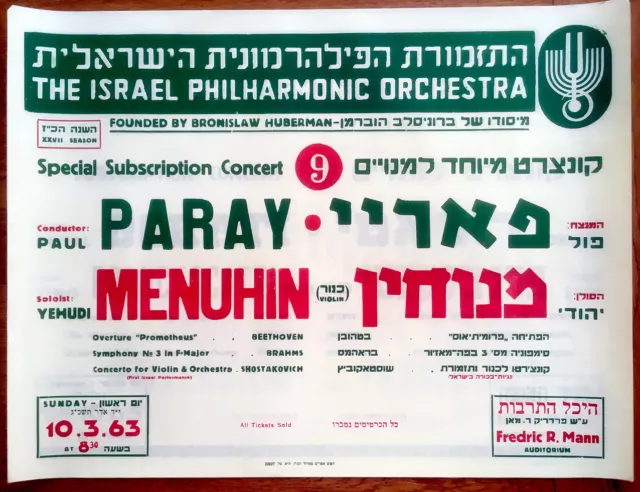
1963 Violin CONCERT POSTER Israel MENUHIN PARAY Violinist IPO Beethoven BRAHMS
$115.00 Buy It Now 30d 11h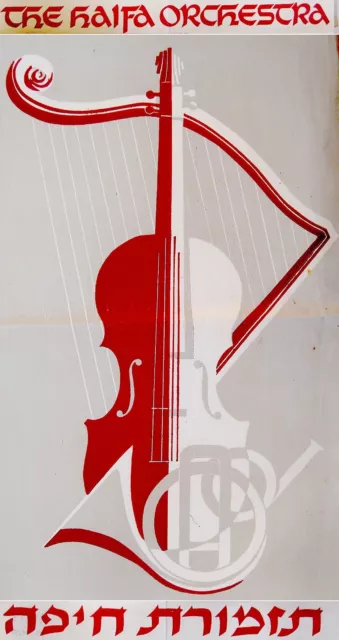
1950 Israel LITHOGRAPH POSTER Haifa ORCHESTRA CONCERT Bach BEETHOVEN De-Falla
$85.00 Buy It Now 20d 9h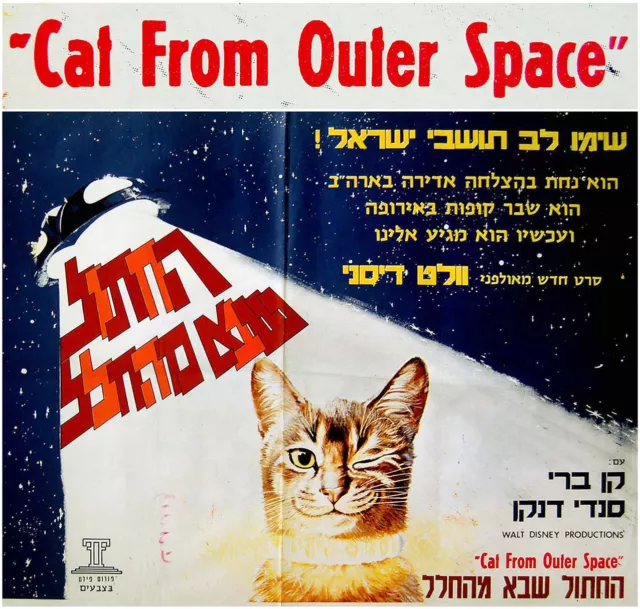
ISRAEL Hebrew RARE FILM POSTER Movie SCIENCE FICTION Disney CAT FROM OUTER SPACE
$89.30 Buy It Now 7d 22h
1965 Beethoven PIANO Rare RECITAL POSTER Israel DANIEL BARENBOIM Hebrew PIANIST
$145.00 Buy It Now 10d 9h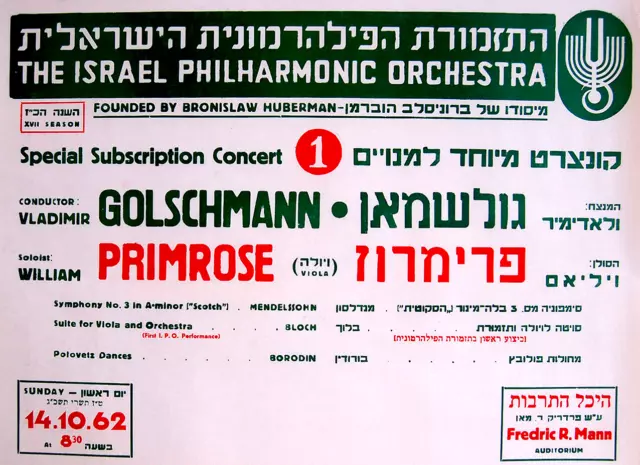
1962 Viola RARE CONCERT POSTER IPO Israel PRIMROSE Mendelssohn GOLSCHMANN Hebrew
$115.00 Buy It Now 20d 18h
1969 Poster ISRAEL INDEPENDENCE DAY Jewish JUDAICA Hebrew HERZL Dayan IDF FLAG
$95.00 Buy It Now 10d 13h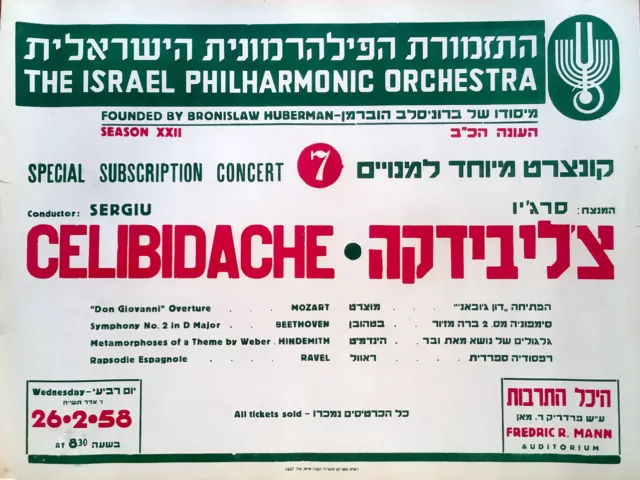
1958 Israel CELIBIDACHE Hebrew CONCERT POSTER Jewish IPO Mozat BEETHOVEN Ravel
$95.00 Buy It Now 29d 13h
1963 Violin CONCERT POSTER Israel NATHAN MILSTEIN Violinist GIULINI Jewish IPO
$115.00 Buy It Now 27d 17h
1960 JUDAICA Children JNF KKL Jewish Holiday RARE ISRAEL POSTER Hebrew BOY GIRL
$46.06 Buy It Now 7d 22h
1946 Hebrew CONCERT POSTER Palestine ORCHESTRA Israel SIGI WEISSENBERG Salzman
$135.00 Buy It Now 23d 11h
1950 Jewish JASCHA HEIFETZ -BERNSTEIN Program VIOLIN CONCERT Haydn BRAHMS Israel
$95.00 Buy It Now 17d 19h
1965 Hebrew MOVABLE Israel CIRCULAR CALCULATOR Jewish GLOBE Bank MAP Judaica
$85.00 Buy It Now 23d 10h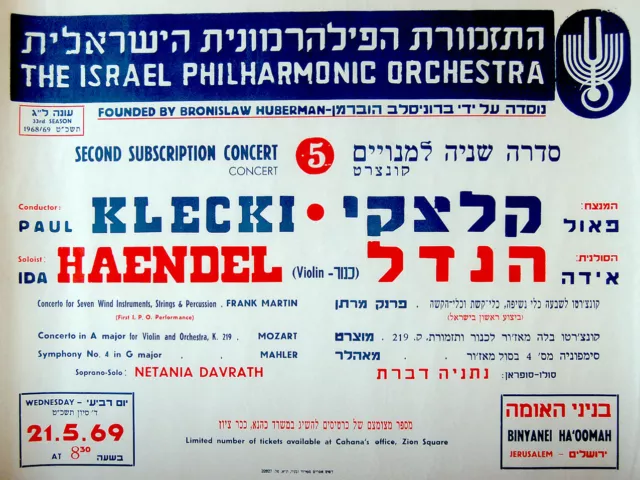
1969 Violin CONCERT POSTER Hebrew IDA HAENDEL Jewish VIOLINIST Israel DAVRATH
$115.00 Buy It Now 28d 13h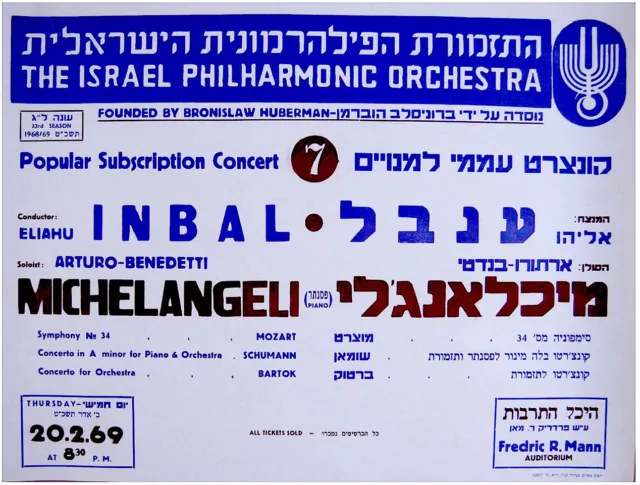
1969 Piano CONCERT POSTER Israel BENEDETTI MICHELANGELI Mozart BARTOK Hebrew
$117.50 Buy It Now 4d 0h
1972 Israel LEONARD BERNSTEIN Hebrew PHOTO PROGRAM Pianist MAHLER CONCERT IPO
$115.00 Buy It Now 18d 15h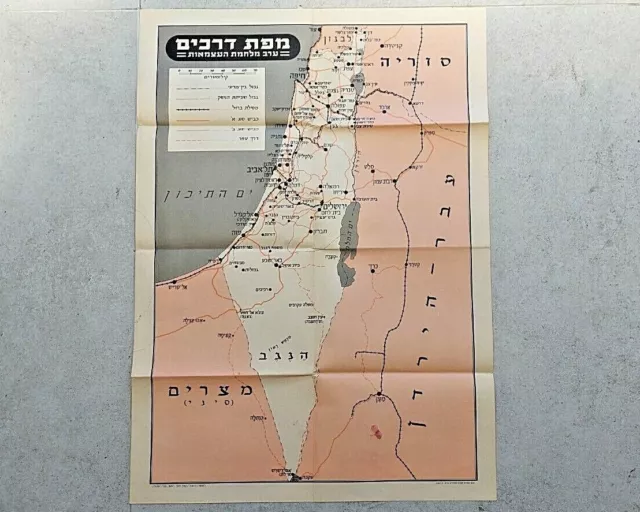
Rare Vtg Poster 1948 Of Israel Palestine Roadmap Lndependence Day War Idf Issued
$44.99 Buy It Now 5d 12h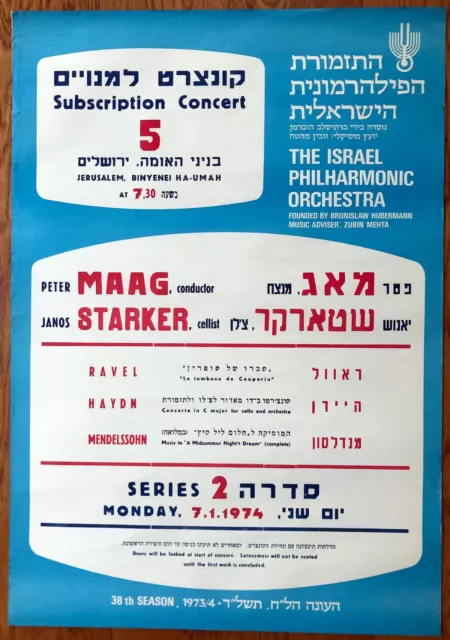
1974 Cello CONCERT POSTER Israel JANOS STARKER Cellist RAVEL Haydn HEBREW Jewish
$115.00 Buy It Now 22d 10h
1962 Israel OPERA Vocal RECITAL POSTER Hebrew VICTORIA DE LOS ANGELES Jewish IPO
$110.00 Buy It Now 12d 10h
Yitzhak Shamir Political Poster Likud Israel 1988
$100.00 Buy It Now 23d 18h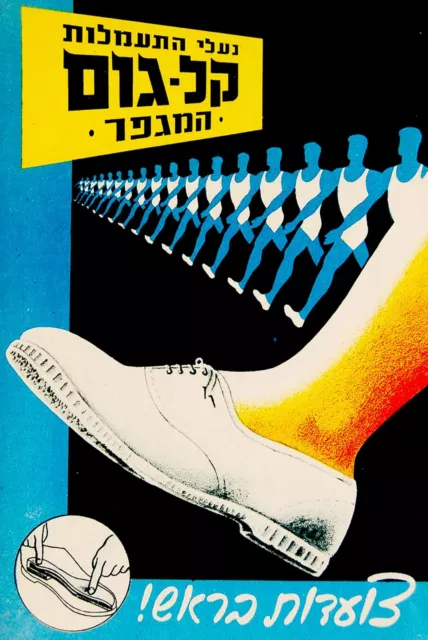
1950 Litho ADVERTISING Rare POSTER Israel SPORTS SHOES Hebrew FOOT WEAR Sneakers
$75.00 Buy It Now 23d 19h
1965 Hebrew ISRAEL POSTER Jewish MACCABI Graphic JUDAICA Forest ZIONIST KKL JNF
$65.00 Buy It Now 26d 13h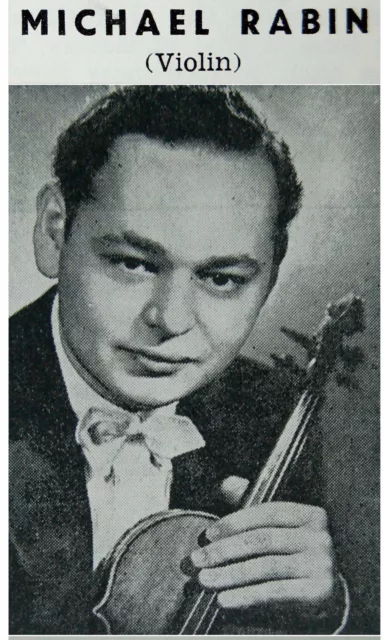
1957 Israel MICHAEL RABIN Program VIOLIN CONCERT Jewish HEBREW Huberman JUDAICA
$108.10 Buy It Now 21d 11h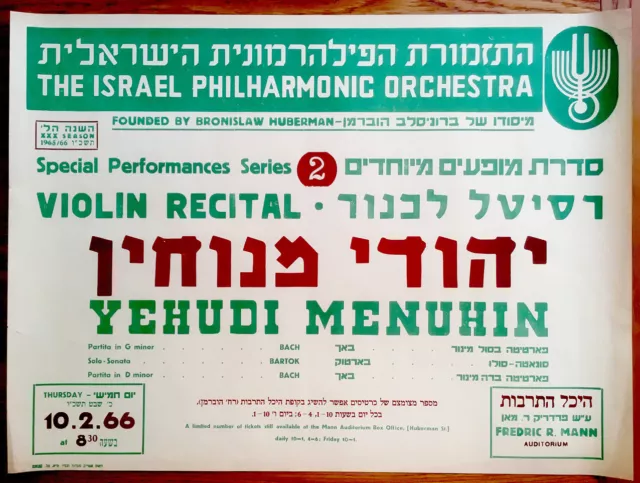
1966 YEHUDI MENUHIN Violin RECITAL Jewish POSTER Israel HEBREW Violinist BARTOK
$125.00 Buy It Now 2d 10h
1959 Israel HAND SIGNED GIULINI Autograph VERDI REQUIEM Photo PROGRAM Israel IPO
$115.00 Buy It Now 14d 9h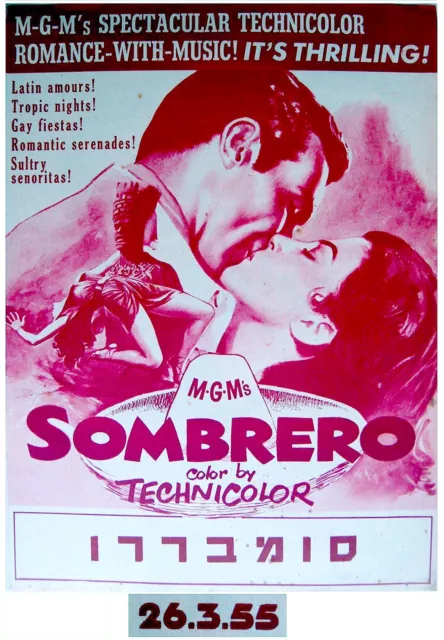
1955 Israel MOVIE Flyer RARE FILM Poster SOMBRERO Jewish CHARISSE Gassman HEBREW
$45.00 Buy It Now 30d 13h
1950 Original PHOTO Jewish VIOLINIST Violin MIRIAM SOLOVIEFF Judaica HOLOCAUST
$75.00 Buy It Now 23d 11h
1959 YEHUDI MENUHIN Violin BACH RECITAL Jewish POSTER Israel HEBREW Violinist
$125.00 Buy It Now 5d 10h
1953 Pianist SIGI WEISSENBERG Hebrew PHOTO PROGRAM Judaica CONCERT Israel JEWISH
$75.00 Buy It Now 11d 15h
1977 VINTAGE ISRAEL TOURIST TRAVEL POSTER VISIT NAHARIYA Honeymoon at any age!
$199.00 Buy It Now 18h 19m 2 watchers
2 watchersValery Klimov Vintage Concert Poster Violin Soviet Violinist George Washington
$295.95 Buy It Now or Best Offer
1959 Violin CONCERT POSTER Israel MICHAEL RABIN Jewish BEETHOVEN Mozart JUDAICA
$115.00$108.10 Buy It Now or Best Offer
